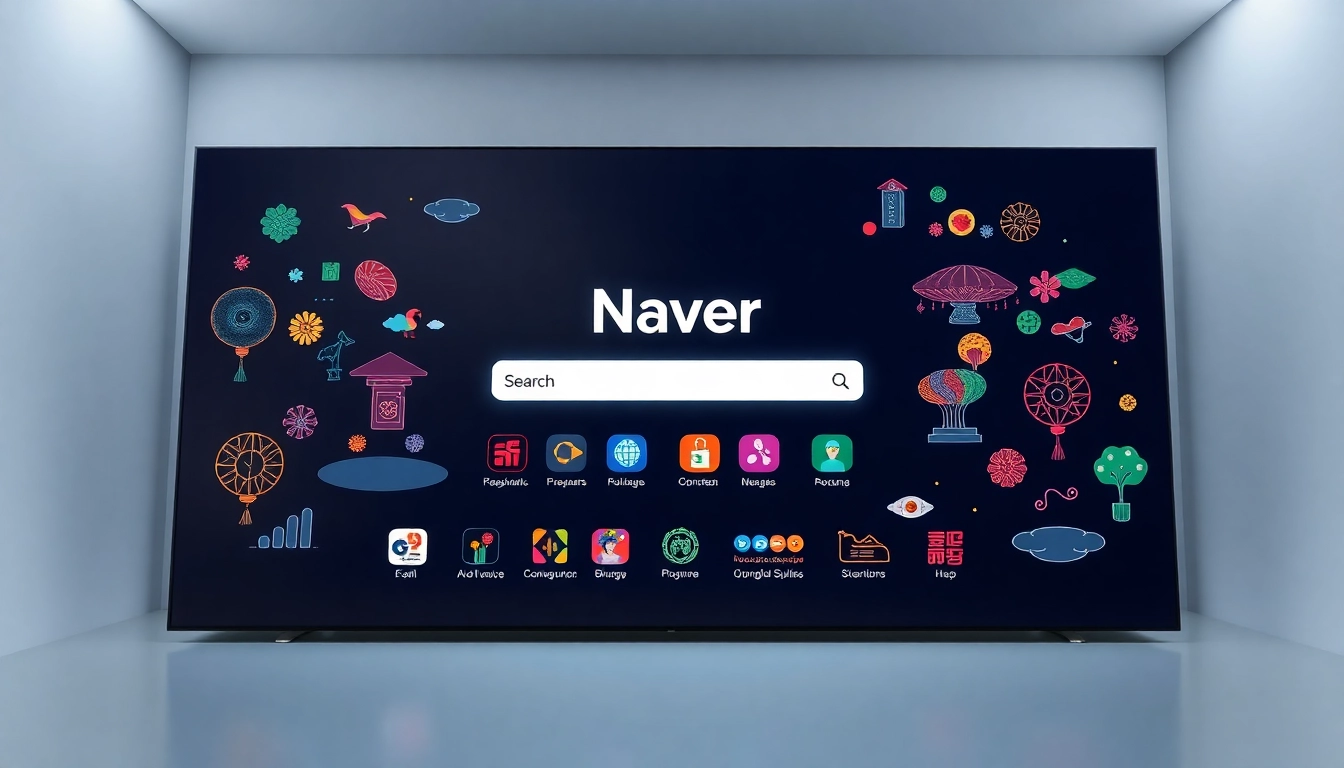Introduction to Naver and Its Role in South Korea’s Digital Ecosystem
Since its launch in June 1999, naver has become a cornerstone of South Korea’s digital landscape. Operated by the Naver Corporation and founded by Lee Hae-jin, this innovative platform initially positioned itself as a search engine but rapidly evolved into a comprehensive ecosystem offering diverse services that intimately connect millions of users daily. With its headquarters in Seongnam-si, Korea, Naver stands as a testament to South Korea’s pioneering approach to internet technology, blending local cultural nuances with cutting-edge innovation.
Understanding Naver’s pivotal role begins with recognizing its profound influence on multiple facets of online life—from search and news to entertainment and mobile commerce. Its unique approach to content aggregation, personalized user experiences, and advanced AI technologies has cemented its dominance among Korean internet users, serving as an indispensable portal for information retrieval and digital interaction. As the platform continues to expand and adapt, examining its history, core features, and strategic growth offers invaluable insights for businesses and digital enthusiasts aiming to leverage its ecosystem for success.
History and Development of Naver
Naver was launched in mid-1999, during a period of rapid internet expansion in South Korea, aiming to meet the rising demand for localized search and online services. Its early focus on Korean language optimization and regional content set it apart from global counterparts. The company’s innovative search algorithms, tailored to Korean linguistic structures, allowed Naver to deliver highly relevant results that quickly built user loyalty.
Throughout the 2000s, Naver expanded into various service domains. Key milestones included the launch of its blogging platform, Que, and the development of knowledge-sharing communities that fostered user-generated content. The company’s strategic investments in AI, machine learning, and mobile technology were critical as smartphone adoption surged in Korea. Notably, Naver’s commitment to local content led to the development of webtoons, a format native to Korea, which became a significant cultural and commercial success.
As competition grew with global giants like Google, Naver differentiated itself further by cultivating a platform that catered specifically to Korean users’ preferences and cultural context. This localization strategy proved pivotal in maintaining its leadership position.
Naver’s Core Services and Offerings
Search Engine and Content Discovery
At its core, Naver’s search engine is designed to prioritize rich, multimedia content, including news, blogs, webtoons, and shopping results, providing users with a comprehensive view tailored to Korean search behaviors. Its integrated AI-powered knowledge graph delivers contextually relevant information, making it more than just a basic search tool.
Blogs and Webtoons
Naver’s blogging platform and webtoon service revolutionized content creation and consumption in Korea. Webtoons, in particular, have grown into a global phenomenon, spawning international audiences and serving as a monetization platform for creators. Naver continues to innovate here, integrating AI tools for content recommendation and creator support, ensuring vibrant community engagement.
Digital Payments and E-Commerce
Naver Pay enables seamless mobile transactions, linked across various Naver services, fostering an integrated shopping experience. E-commerce integrations through Naver Shopping provide a curated marketplace reflecting Korean consumer preferences, with advanced features like price comparisons and real-time deals.
News and Media Integration
Naver aggregates news from countless sources, delivering personalized news feeds that cater to users’ interests. Its AI-driven algorithms ensure relevant, timely content, while providing publishers with extensive reach within the platform’s ecosystem.
Understanding Naver’s Search Engine and Content Ecosystem
How Naver’s Search Engine Works in Korea
Naver’s search engine employs sophisticated algorithms optimized for the Korean language, incorporating natural language processing specific to Hangul, Hanja, and mixed scripts. Its knowledge graph system not only delivers straightforward search results but also offers direct answers, snippets, and multimedia-rich content that reduce the need for users to visit multiple sites.
Distinct from Google, Naver’s algorithm prioritizes content within its own ecosystem—such as blogs, webtoons, and news—making it a platform that encourages content creation as an entry point to increased visibility.
Integration of Blogs, Webtoons, and News
Content integration within Naver allows for seamless navigation between different content types. For example, a search for a celebrity may display news articles, blogs, webtoons, and videos in a single-rich result page, helping users find diverse perspectives and media formats. This interconnectedness enhances engagement and promotes content creators directly within the platform.
Leveraging AI and Personalization Features
Naver’s AI-driven personalization tailors feeds and search results based on user behavior, preferences, and browsing history. The platform’s AI capabilities also support voice search, image recognition, and recommendation engines, transforming user interactions into highly contextual and relevant experiences.
Maximizing Naver for Business and Marketing Strategies
Advertising Opportunities on Naver
For advertisers, Naver provides robust options including search advertising (similar to Google Ads), banner placements, and native advertising tailored to user interests. Sponsored content within blogs, webtoons, and Naver News offers targeted exposure to highly engaged audiences.
SEO Optimization for Naver Search
Unlike global engines, Naver’s SEO requires understanding its ecosystem. Optimization involves creating high-quality, localized content with relevant keywords, ensuring blog and webtoon engagement, and leveraging Naver’s native tools such as its blog platform and webtoon services for visibility. Regular updates, keyword analysis, and content diversification are key to climbing Naver’s rankings.
Content Creation and Engagement Tips
Successful brands often utilize Naver’s content channels to build community trust. Producing authentic blog posts, webtoons, and interactive media aligned with Korean cultural trends enhances brand affinity. Engaging with users via comments, participating in Naver’s knowledge-sharing forums, and leveraging influencer partnerships are additional strategies to amplify reach.
Using Naver’s Mobile Apps and Maps for Daily Convenience
Naver App Features for Users
The Naver app consolidates search, news, shopping, and entertainment into a single interface optimized for mobile. Features like real-time news feeds, weather updates, and integrated shopping make daily life more convenient. The AI-based recommendation system further personalizes content delivery.
Naver Map for Navigation and Traffic Updates
Naver Map is Korea’s leading navigation app, providing accurate directions, real-time traffic information, and public transport guidance. Its features include 360-degree rotation, indoor maps, and route optimization, essential for daily commuting or exploring new areas.
Integrating Naver Services into Business Portfolios
Businesses can incorporate Naver services such as Naver Smart Store and Naver Pay into their digital strategies. Establishing a presence on Naver Map or leveraging the platform’s advertising tools enhances local visibility, especially critical for retailers and service providers targeting Korean consumers.
Future Trends and Innovations from Naver
Upcoming Technology and AI Developments
Naver continues to invest heavily in AI, with developments in conversational AI, robotics, and autonomous vehicles through Naver Labs. Anticipated breakthroughs include more sophisticated voice assistants and AI-driven content moderation systems, enhancing security and personalization.
Naver’s Role in Korea’s Smart City Initiatives
As South Korea advances toward smart city developments, Naver’s integrated platforms are expected to underpin urban management, traffic optimization, and public service delivery. Its data analytics and AI capabilities position it as a key player in these initiatives.
Global Expansion and Emerging Markets
Naver has begun exploring international markets, particularly Southeast Asia, leveraging its strong localization expertise and AI innovations. Strategic partnerships and webtoon globalization efforts aim to extend Naver’s influence beyond Korea’s borders.



